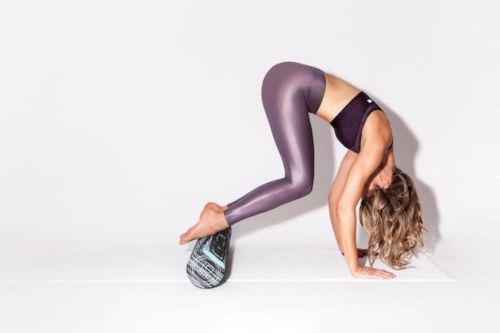Is there anyone who hasn’t dealt with annoying bloating at some point (if that’s you, I want to know your secret ASAP). Whether you experience a little gassiness on the reg, or maybe just occasionally, it doesn’t hurt to have a few tools in your wellness arsenal to use when it strikes. One powerful, yet unexpected one that you probably already own? The foam roller. And if you, like me, might be wondering how to use a foam roller to banish bloat, I’ve got you.
The foam roller is most commonly tapped to help work out sore muscles, but it can also be used like a yoga block to support poses that ease tumultuous digestive episodes. Just ask Lauren Roxburgh, body alignment specialist and fascia expert, who’s worked with a roster of A-listers that range from celebs to star athletes to high-profile surgeons.
When I try the foam rolling sequence that she’s created, just for this, I find that it’s a nice meeting point between yoga and a massage (win!), with many of the same yogic moves that my instructors say help to promote healthy digestion. “Twisting and inverting both help gentle pressure to the belly, like an internal massage for our intestines. This rolling sequence uses deep breathing twisting and forward folds to help stimulate the abdominal organs, while also increasing the efficiency of the bowels, relieving constipation and helping minimize belching and gas,” she says. Here, the six moves you can do anytime the bloat struggle is real to help keep things moving.
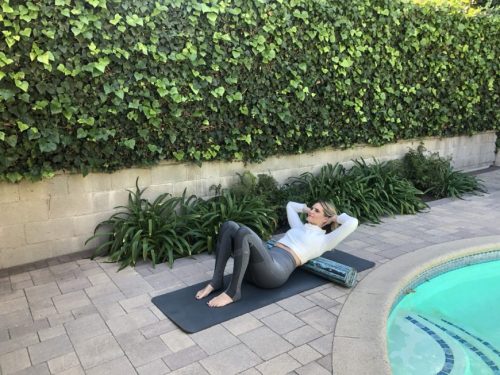
1. Belly breathing
“Deep breathing is like an internal shower for your organs. It helps activate your transverse abdominis (essentially your laughing and coughing muscles), and also helps flush out the stagnant CO2 to create space for new oxygen to invigorate your cells,” says Roxburgh. “Start with the roller underneath your middle back. Place your hands behind your head and inhale slowly to fill up the lungs as you lean back and over the roller, think about expanding the lungs three-dimensionally.” Exhale fully as you come up, closing off the ribs. Repeat eight times.
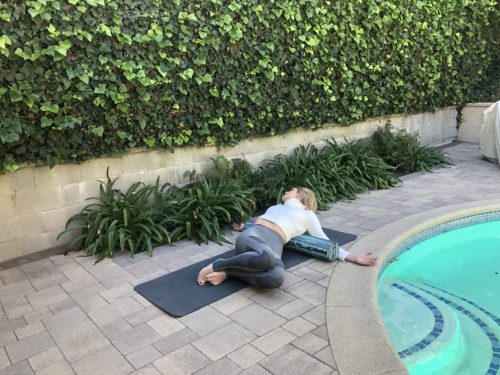
2. Roller-supported twist
“Twisting helps wring out the organs and stimulates and supports proper digestion and elimination,” says Roxburgh. “Start with the roller underneath the middle back. Take your arms around the end of the roller and twist your knees and hips over to the right, and your head to left.” Come back to the center and then do the same on the other side, repeating eight times on each side.

3. Propped up inversion
“Place the roller underneath the lower back so your hips are supported. Bring the knees up and keep them bent,” says Roxburgh. “Slowly angle the knees over to the right, exhaling as you lower, and then over to the left side.” Repeat this motion eight times on each side.
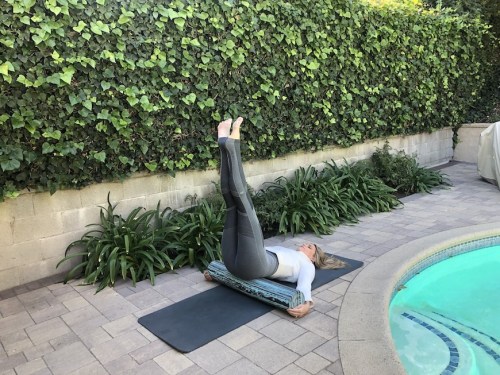
4. Inverted core activation
“Start with the roller underneath your hips and place your hands on either side of the roller to support you. Then, push your heels together and your toes apart, with your legs raised towards the ceiling,” she says. “Lower your legs, activating and engaging the core, and inhale on the way down.” As you exhale, raise your legs back up slowly and repeat eight times.
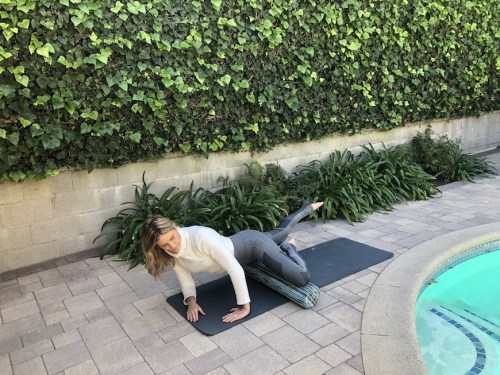
5. Psoas roll
“The psoas is our deepest core muscle and lies on the front of the spine just under the abdominal muscles and organs and is connected to the diaphragm through connective tissue or fascia. This move helps you connect to the deepest part of your core,” she says. “Place the roller underneath the top of your thighs, right underneath the pubic bone. Bend the right knee, and come down onto your left forearm, reach the left leg long and roll up into the outer part of the hip and up into the psoas.” Repeat five times on each side.

6. Mermaid twist
“Start with your right shin in front of you and your left shin out to the left so that your knees are staggered. Place the roller to the right of you and place your hands on the roller. Reach and lift your sides and lift through the top of your head,” Roxburgh says. “Inhale and roll the roller up your forearms to just below your elbows. Exhale as you roll back up to the starting position.” Repeat five full rounds, and then switch sides.
Simone De La Rue is another celeb trainer who swears by the foam roller. And these are the best herbs for bloating, according to Chinese Medicine.
Sign Up for Our Daily Newsletter
Get all the latest in wellness, trends, food, fitness, beauty, and more delivered right to your inbox.
Got it, you've been added to our email list.
